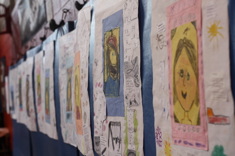In Part I of this feature, I shared some projects, expectations, and activities for our Poetry Café celebration. This is an event where families enjoyed listening to their children read poems, recite them with a friend, and share some of their work completed during the year.
For students to be ready to share poetry with their families that night, there was a lot of advance preparation and practice. This was definitely an authentic and purposeful way to explain to students the importance of rereading and fluency. I presented several minilessons where I explained how to read with expression through pitch and rhythm, as well as pausing at specific punctuation. The lessons were useful and meaningful, since students spent weeks practicing reading poems alone or with partners.
The final fluency project included recording all students reading their poems using Garage Band software and making a copy for each family to take home after their performances the evening of the Poetry Cafe. This recording project served two purposes: creating a CD with poetry performances to apply everything they’d learned during our minilessons, and enabling families to hear their child reading the poems, especially if they couldn’t attend our ESL Poetry Café event.
In Part I of this feature, I explained how families and students were encouraged to take a gallery walk around the gym to read poetry posters and leave comments on postcards. This was a wonderful opportunity for families and friends to connect with one another, to read other children’s work, and to be attentive to details in order to write meaningful comments.
The second part of this evening consisted of students performing their poetry in front of the community. For the performance, students worked with a partner, reciting poetry in two voices. Other students read favorite poems, and a small group read some nursery rhymes and poetry in Spanish. We used several wonderful books to prepare for reading aloud during the evening. Here is a list of our favorites.
You Read to Me, I’ll Read to You by Mary Ann Hoberman
I’m a big fan of Mary Ann Hoberman. Her work is brilliant and versatile for classroom use. This collection has helped my students understand how to read with expression, how to read with a partner and help one another, how to read with wonderful fluency, and how to find patterns as writers. One of the best investments I have made for my classroom is to purchase several copies of this book, since the uses and possibilities are unlimited.
Mama Goose: A Latino Nursery Treasury by Alma Flor Ada and Isabel Campoy
This is one of the few bilingual books that includes a large collection of rhymes, riddles, and songs from Spanish-speaking cultures. Many Hispanic students will identify with some of the rhymes found in this book, since they may revive childhood memories.
Pio Peep! by Alma Flor Ada and Isabel Campoy
This is another excellent publication by the same authors of Mama Goose: A Latino Nursery Treasury. This is a worthy companion to that text, and a great way to introduce bilingual poems (Spanish and English) to children.
Laughing Tomatoes: And Other Spring Poems/Jitomates Risuenos: Y Otros Poemas de Primavera by Francisco X. Alarcon
I am confident that if I purchase a book by Francisco X. Alarcon, my students will enjoy it. His poetry books all include rich language, rhythm, and respect for different cultures that inspires. Other titles by Alarcon include Angels Ride Bikes and Other Fall Poems; and From the Bellybutton of the Moon: And Other Summer Poems
.
One important final detail to consider when putting any event together is the environment. The setting plays a big role in inspiring and encouraging people to participate, learn, cooperate, or simply enjoy themselves.
For this particular event I wanted to re-create a cafe look. By bringing in red-and-white-checked tablecloths, plants, flameless candles, and lots of artwork, the environment of our gymnasium changed completely. All these elements contributed to the artistic mood that poems and children’s artwork inspire.
It is my hope that all children will have an authentic poetry celebration at some point in their education. Poetry is a special part of the journey of becoming a reader and a writer for many children, and spring is the perfect time to celebrate this genre.






